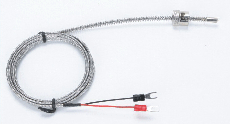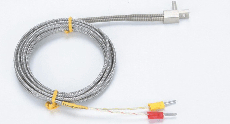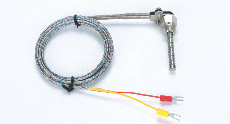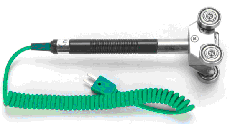- Heater
-
- Cartridge Heaters
- Tubular Heaters
- Air Finned Heaters
- Flange Immersion Heaters
- Screw Plug Immersion Heaters
- Coil Heaters
- Manifold Heaters
- Mica Band Heaters
- Ceramic Band Heaters
- Brass Nozzle Heaters
- Cast In Heaters
- Flexible Ceramic Pad Heater
- Silicone Rubber Heaters
- Ceramic Heaters
- FIR Tube Heaters(Blackbody Heaters)
- Quartz Heaters
- Heater Accessory
- Temperature Sensors
- Alloy
Themocouple
A thermocouple is a sensor that measures temperature. It consists of two different types of metals, joined together at one end. When the junction of the two metals is heated or cooled, a voltage is created that can be correlated back to the temperature. Thermocouple alloys are commonly available as wire. Thermocouples are widely used in science and industry; applications include temperature measurement for kilns, gas turbine exhaust, diesel engines, and other industrial processes. Thermocouples are also used in homes, offices and businesses as the temperature sensors in thermostats, and also as flame sensors in safety devices for gas-powered major appliances.
 Temperature range
Temperature range
Category |
Code |
Temperature Range |
Ni-Cr-Si----Ni-Si-Mg |
N |
0°C ~ 1200°C |
Ni-Cr----Ni-Si |
K |
0°C ~ 1200°C |
Ni-Cr----Cu-Ni |
E |
0°C ~ 800°C |
Fe----Cu-Ni |
J |
0°C ~ 750°C |
Cu----Cu-Ni |
T |
0°C ~ 350°C |
Pt-Rh13----Pt |
R |
0°C ~ 1600°C |
Pt-Rh10----Pt |
S |
0°C ~ 1600°C |
Pt-Rh30----Pt-Rh6 |
B |
0°C~ 1700°C |

 Measuring junction
Measuring junction
|
Type |
Features |
Outer diameter of universal sleeve |
|
Single couples |
Double couples |
|||
1 |
Ungrounded |
1 It responses more slowly than that of the case-connected type. |
Φ0.5 ~Φ8.0 |
Φ3.0 ~Φ8.0 |
2 |
Grounded |
1 Rapid response |
Φ0.25 ~Φ8.0 |
Φ3.0 ~Φ8.0 |
3 |
Exposed |
1 Rapid response |
Φ0.5 ~Φ8.0 |
Φ3.0 ~Φ8.0 |
 Thermocouple and RTD
Thermocouple and RTD
 Hand-Held Thermocouple
Hand-Held Thermocouple

The two most common ways of measuring industrial temperatures are with resistance temperature detectors (RTDs) and thermocouples. Choice between them is usually determined by four factors. Temperature: If process temperatures are between −200 to 500 °C (−328.0 to 932 °F), an industrial RTD is the preferred option. Thermocouples have a range of −180 to 2,320 °C (−292.0 to 4,210 °F), so for temperatures above 500 °C (932 °F) they are the only contact temperature measurement device. Response time: If the process requires a very fast response to temperature changes—fractions of a second as opposed to seconds (e.g. 2.5 to 10 s)—then a thermocouple is the best choice. Time response is measured by immersing the sensor in water moving at 1 m/s (3 ft/s) with a 63.2% step change. Size: Class A RTD sheath is 3.175 to 6.35 mm (0.1250 to 0.250 in) in diameter; sheath diameters for thermocouples can be less than 1.6 mm (0.063 in). Accuracy and stability requirements: If a tolerance of 2 °C is acceptable and the highest level of repeatability is not required, a thermocouple will serve. RTDs are capable of higher accuracy and can maintain stability for many years, while thermocouples can drift within the first few hours of use.

-
THERMOCOUPLE & RTD WIRE
Insulation material: fiberglass, PTFE, PVC, silicone Thermocouple Type: K,J,T,E,,N,R,S,B RTD Type: Cu50,Cu100,Pt100 Size: from AWG 8 to AWG 40

-
THERMOCOUPLE & RTD CONNECTOR
Used for thermocouple and RTD circuits.

-
THERMOCOUPLE & RTD HEAD
Body Material: Aluminum,SS304,SS316 Material of terminal block: ceramic or Bakelite Form of terminal block:2P,3P,4P,6P




































